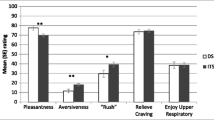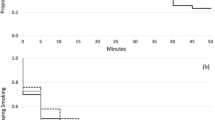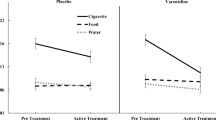Abstract
Objective and rationale
Smoking lapses represent an important juncture between smoking cessation and relapse. Nicotine replacement therapy (NRT) has been shown to decrease the risk of progression from lapse to relapse. We hypothesized that this effect might be mediated via decreases in reinforcement from smoking lapses.
Method
We assessed 169 subjects who lapsed during treatment in a double-blind placebo-controlled study of high-dose (35 mg) nicotine patch. Following their first lapse, using an electronic diary, subjects recorded the amount they smoked, and rated the pleasantness and satisfaction (“hedonic rating”) and the aversiveness of smoking. Subjects were then followed and assessed for further lapses and relapses.
Results
Subjects who smoked more during the first lapse had greater risk of progression [second lapse: hazard ratio (HR)=1.16, confidence interval (CI)=1.01–1.32; relapse: HR=1.22, CI=0.97–1.54]. Subjects with higher hedonic ratings of the first lapse also had a greater risk of progression to the second lapse (HR=1.08, CI=1.02–1.14) and to relapse (HR=1.26, CI=1.11–1.41). Aversive ratings had no bearing on progression. As expected, active treatment reduced the risk of both a second lapse (HR=0.54, CI=0.39–0.78) and a relapse (HR=0.22, CI=0.11–0.45). Importantly, however, NRT had no effect on hedonic ratings, amount smoked during the first lapse, or aversive ratings.
Conclusions
Hedonic response to an initial lapse predicted progression to relapse, but this did not mediate the effect of NRT on progression.



Similar content being viewed by others
Notes
Because many second lapses (27.8%) occurred on the same day as the first lapse, we also analyzed time to second lapse using hours as the unit of analysis. As the results were largely the same, we have not presented these analyses.
As less than half of the sample reached the relapse end point, the median value presented underestimated the true median for all subjects who would eventually relapse.
When considering the comparison between baseline ratings and lapse hedonic ratings, it should be noted that the two “assessments” were not strictly identical. Firstly, the smoking “situation” was different—whereas lapse assessments were likely colored by feelings of guilt and disappointment, it was unlikely that such feelings were present during baseline smoking. Additionally, baseline assessment could have been performed up to 30 min after finishing the cigarette being rated and, hence, was subjected to a greater degree of memory “bias.” Nevertheless, we feel that the comparison was still informative.
In addition, the effect of patch, as noted in Levin et al. (1994), was found in hedonic ratings on weeks 2 and 3 of treatment, not during the first week of treatment (when most of our first-lapse episodes were obtained). To test whether our findings might be affected by differential reactions to early (week 1) vs later lapses, we divided our sample into lapses in week 1 and later. There was no indication of an effect of time: the effects were very nearly identical and the time × treatment interaction was nonsignificant (p>0.90).
References
Baron RM, Kenny DA (1986) The moderator–mediator variable distinction in social psychological research: conceptual, strategic, and statistical considerations. J Pers Soc Psychol 51:1173–1182
Berridge KC, Robinson TE (1998) What is the role of dopamine in reward: hedonic impact, reward learning, or incentive salience? Brains Res Rev 28:309–369
Berridge KC, Robinson TE (2003) Parsing reward. Trends Neurosci 26:507–513
Borland R (1990) Slip-ups and relapse in attempts to quit smoking. Addict Behav 15:235–245
Brandon TH, Tiffany ST, Obremski KM, Baker TB (1990) Postcessation cigarette use: the process of relapse. Addict Behav 15:105–114
Brownell KD, Marlatt GA, Lichtenstein E, Wilson GT (1986) Understanding and preventing relapse. Am Psychol 41:765–782
Chornock WM, Stitzer ML, Gross J, Leischow S (1992) Experimental model of smoking re-exposure: effects on relapse. Psychopharmacology 108:495–500
Cohen J (1988) Statistical power analysis for the behavioral sciences, 2nd edn. Lawrence Erlbaum Associates, Hillsdale, NJ
deWit H, Stewart J (1981) Reinstatement of cocaine-reinforced responding in the rat. Psychopharmacology (Berl) 75:134–143
deWit H, Stewart J (1983) Drug reinstatement of heroin reinforced responding in the rat. Psychopharmacology (Berl) 79:29–31
Eissenberg T, Balster RL (2000) Initial tobacco use episodes in children and adolescents: current knowledge, future directions. Drug Alcohol Depend 59:41–60
Fant RV, Schuh KJ, Stitizer ML (1995) Response to smoking as a function of prior smoking amounts. Psychopharmacology (Berl) 119:385–390
Foulds J, Stapleton J, Feyerabend C, Vesey C, Jarvis M, Russell MAH (1992) Effect of transdermal nicotine patches on cigarette smoking: a double blind crossover study. Psychopharmacology (Berl) 106:421–427
Friedman LS, Lichtenstein E, Biglan A (1985) Smoking onset among teens, an empirical analysis of initial situations. Addict Behav 10:1–13
Glautier S (2004) Measures and models of nicotine dependence: positive reinforcement. Addiction 99(Suppl 1):30–50
Hahn G, Charlin VL, Sussman S, Dent CW, Flay B, Hansen WB, Burton D (1990) Adolescents’ first and most recent use situations of smokeless tobacco and cigarettes: similarities and differences. Addict Behav 15:439–448
Hajek P, Stead LF, West R, Jarvis M (2005) Relapse prevention interventions for smoking cessation. Cochrane Database Syst Rev 25:CD003999
Kenford SL, Fiore MC, Jorenby DE, Smith SS, Welter D, Baker TB (1994) Predicting smoking cessation: who will quit with and without the nicotine patch. JAMA 271:589–594
Leri F, Stewart J (2002a) The consequences of different “lapses” on relapse to heroin seeking in rats. Exp Clin Psychopharmacol 10:339–349
Leri F, Stewart J (2002b) Advantages and disadvantages of studying the process of relapse in rats: reply to Baker and Curtin (2002), Bardo (2002), Goeders (2002), Marlatt (2002), and Tiffany and Conklin (2002) Exp Clin Psychopharmacol 10:364–366
Levin ED, Westman EC, Stein RM, Carnahan E, Sanchez M, Herman S et al (1994) Nicotine skin patch treatment increases abstinence, decreases withdrawal symptoms, and attenuates rewarding effects of smoking. J Clin Psychopharmacol 14:41–49
Lichtenstein E, Glasgow RE (1992) Smoking cessation: what have we learned over the past decade? J Consult Clin Psychol 60:518–527
Marlatt GA, Gordon JR (1985) Relapse prevention. Guildford Press, New York
Mathieu-Kia AM, Kellogg SH, Butelman ER, Kreek MJ (2002) Nicotine addiction: insights from recent animal studies. Psychopharmacology (Berl) 162:102–118
Nil R, Woodson PP, Battig K (1987) Effects of smoking deprivation on smoking behavior and heart rate response in high and low CO absorbing smokers. Psychopharmacology (Berl) 92:465–469
Ockene JK, Emmons KM, Mermelstein RJ, Perkins KA, Bonollo DS, Voorhees C et al (2000) Relapse and maintenance issues for smoking cessation. Health Psychol 19:17–31
Ossip-Klein DJ, Bigelow G, Parker SR, Curry S, Hall S, Kirkland S (1986) Task force 1: classification and assessment of smoking behavior. Health Psychol 5:3–11
Perkins KA, DiMarco A, Grobe JE, Scierka A, Stiller RL (1994a) Nicotine discrimination in male and female smokers. Psychopharmacology (Berl) 116:407–413
Perkins KA, Epstein LH, Grobe J, Fonte C (1994b) Tobacco abstinence, smoking cues, and the reinforcing value of smoking. Pharmacol Biochem Behav 47:107–112
Pomerleau OF, Pomerleau CS (1992) Euphoriant effects of nicotine in smokers. Psychopharmacology (Berl) 108:460–465
Pomerleau OF, Pomerleau CS, Namenek RJ (1998) Early experiences with tobacco among women smokers, ex-smokers, and never-smokers. Addiction 93:595–599
Robinson TE, Berridge KC (2001) Incentive-sensitization and addiction. Addiction 96:103–114
Rose JE (1984) Discriminability of nicotine in tobacco smoke: implications for titration. Addict Behav 9:189–193
Rose JE, Westman EC, Behm FM, Johnson MP, Goldberg JS (1999) Blockade of smoking satisfaction using the peripheral nicotinic antagonist trimethaphan. Pharmacol Biochem Behav 62:165–172
Shaham Y, Shalev U, Lu L, deWit H, Stewart J (2003) The reinstatement model of drug relapse: history, methodology and major findings. Psychopharmacology (Berl) 168:3–20
Shiffman S (1982) Relapse following smoking cessation: a situational analysis. J Consult Clin Psychol 50:71–86
Shiffman S, Hickcox M, Paty JA, Gnys M, Kassel JD, Richards TJ (1996a) Progression from a smoking lapse to relapse: prediction from abstinence violation effects, nicotine dependence, and lapse characteristics. J Consult Clin Psychol 64:993–1002
Shiffman S, Paty JA, Gnys M, Kassel JD, Hickcox M (1996b) First lapses to smoking: within subjects analysis of real time reports. J Consult Clin Psychol 64:366–379
Shiffman S, Ferguson SG, Gwaltney C, Balabanis M, Shadel W (in press-a) Reduction of abstinence induced withdrawal and craving using nicotine replacement therapy. Psychopharmacology
Shiffman S, Scharf D, Shadel W, Gwaltney C, Dang Q, Paton S, Clark D (in press-b) Analyzing milestones in smoking cessation: an illustration from a randomized trial of high dose nicotine patch. J Consult Clin Psychol
Stewart J, de Wit H, Eikelboom R (1984) Role of unconditioned and conditioned drug effects in the self-administration of opiates and stimulants. Psychol Rev 91:251–268
Stone AA, Shiffman S (1994) Ecological momentary assessment (EMA) in behavioral medicine. Ann Behav Med 16:199–202
Sutton SR (1989) Relapse following smoking cessation: a critical review of current theory and research. In: Gossop M (ed) Relapse and addiction behaviour. Routledge, London, pp 41–72
Tiffany ST (1990) A cognitive model of drug urges and drug-use behavior: role of automatic and nonautomatic processes. Psychol Rev 97:147–168
Waters AJ, Shiffman S, Bradley BP, Mogg K (2003a) Attentional shifts to smoking cues in smokers. Addiction 98:1409–1417
Waters AJ, Shiffman S, Sayette MA, Paty JA, Gwaltney CJ, Balabanis MH (2003b) Attentional bias predicts outcome in smoking cessation. Health Psychol 22:378–387
Waters AJ, Shiffman S, Sayette MA, Paty JA, Gwaltney CJ, Balabanis MH (2004) Cue provoked craving and nicotine replacement therapy in smoking cessation. J Consult Clin Psychol 72:1136–1142
Wise RA (1996) Addictive drugs and brain stimulation reward. Annu Rev Neurosci 19:319–340
Acknowledgements
This research was supported by a grant (DA 06084) from the National Institute on Drug Abuse to Saul Shiffman. We are grateful to GlaxoSmithKline Consumer Healthcare (GSKCH) for providing nicotine and placebo patches for the study (GSKCH did not otherwise participate in the study or in the paper).
Author information
Authors and Affiliations
Corresponding author
Additional information
Fund declarations
Saul Shiffman and Stuart Ferguson consult exclusively for GlaxoSmithKline Consumer Healthcare on matters relating to existing smoking cessation products. Dr. Shiffman also has an interest in a new smoking cessation product and is a founder of invivodata, which provides electronic diaries for clinical trials.
Rights and permissions
About this article
Cite this article
Shiffman, S., Ferguson, S.G. & Gwaltney, C.J. Immediate hedonic response to smoking lapses: relationship to smoking relapse, and effects of nicotine replacement therapy. Psychopharmacology 184, 608–618 (2006). https://doi.org/10.1007/s00213-005-0175-4
Received:
Accepted:
Published:
Issue Date:
DOI: https://doi.org/10.1007/s00213-005-0175-4




